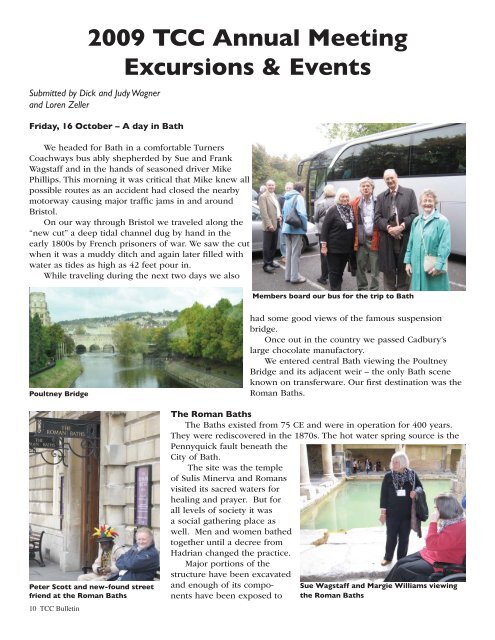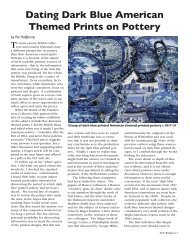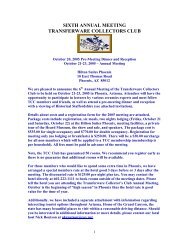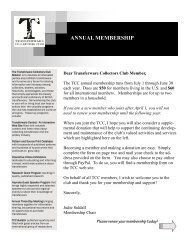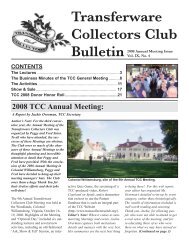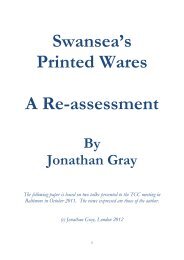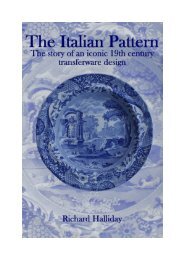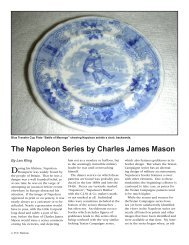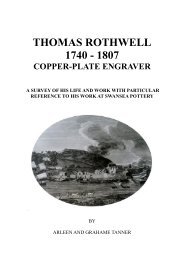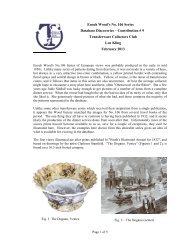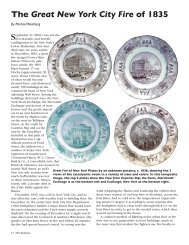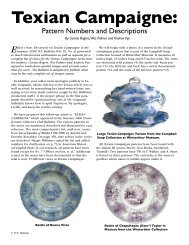TCC Annual Meeting09.indd - Transferware Collectors Club
TCC Annual Meeting09.indd - Transferware Collectors Club
TCC Annual Meeting09.indd - Transferware Collectors Club
You also want an ePaper? Increase the reach of your titles
YUMPU automatically turns print PDFs into web optimized ePapers that Google loves.
2009 <strong>TCC</strong> <strong>Annual</strong> Meeting<br />
Excursions & Events<br />
Submitted by Dick and Judy Wagner<br />
and Loren Zeller<br />
Friday, 16 October – A day in Bath<br />
We headed for Bath in a comfortable Turners<br />
Coachways bus ably shepherded by Sue and Frank<br />
Wagstaff and in the hands of seasoned driver Mike<br />
Phillips. This morning it was critical that Mike knew all<br />
possible routes as an accident had closed the nearby<br />
motorway causing major traffic jams in and around<br />
Bristol.<br />
On our way through Bristol we traveled along the<br />
“new cut” a deep tidal channel dug by hand in the<br />
early 1800s by French prisoners of war. We saw the cut<br />
when it was a muddy ditch and again later filled with<br />
water as tides as high as 42 feet pour in.<br />
While traveling during the next two days we also<br />
Members board our bus for the trip to Bath<br />
Poultney Bridge<br />
Peter Scott and new-found street<br />
friend at the Roman Baths<br />
10 <strong>TCC</strong> Bulletin<br />
had some good views of the famous suspension<br />
bridge.<br />
Once out in the country we passed Cadbury’s<br />
large chocolate manufactory.<br />
We entered central Bath viewing the Poultney<br />
Bridge and its adjacent weir – the only Bath scene<br />
known on transferware. Our first destination was the<br />
Roman Baths.<br />
The Roman Baths<br />
The Baths existed from 75 CE and were in operation for 400 years.<br />
They were rediscovered in the 1870s. The hot water spring source is the<br />
Pennyquick fault beneath the<br />
City of Bath.<br />
The site was the temple<br />
of Sulis Minerva and Romans<br />
visited its sacred waters for<br />
healing and prayer. But for<br />
all levels of society it was<br />
a social gathering place as<br />
well. Men and women bathed<br />
together until a decree from<br />
Hadrian changed the practice.<br />
Major portions of the<br />
structure have been excavated<br />
and enough of its components<br />
have been exposed to<br />
Sue Wagstaff and Margie Williams viewing<br />
the Roman Baths
provide an explanation (via audio guides) of<br />
how the baths were engineered and used. Also<br />
on display were artifacts found: mosaics, jewelry,<br />
tools, pottery, prayers, coins, etc. The site<br />
was far too huge to fully explore in the time<br />
available but surely a place to revisit and wander<br />
anew.<br />
From the baths we coached to Wood’s<br />
Restaurant and were refreshed by an excellent<br />
lunch.<br />
After our meal, members split into two<br />
smaller groups. Some walked to the nearby Museum<br />
of East Asian Art, others to the Georgian<br />
House and Museum, #1 Royal Crescent. Then<br />
we switched sites.<br />
Scottish Members David and Catriona Maisels enjoy lunch with<br />
Frank Wagstaff at Woods Restaurant<br />
Museum of East Asian Art<br />
The Museum was established sixteen years ago based on the<br />
collection of Brian McElney. McElney retired to Bath from Hong<br />
Kong. We explored three floors of museum holdings guided by<br />
the curator Michel Lee. His early discussions focused on material<br />
of the Tang Dynasty (618-907 CE) considered a golden age when<br />
trade along the Silk Road was at its peak. This was also the period<br />
when cobalt pigment was first used in China. It was imported<br />
from Persia or central Asia where it was already in use. The pigment<br />
was very expensive and highly valued. A lead glaze was<br />
common on wares but people soon learned of its poisonous effect<br />
so lead was reserved for decorative items.<br />
We were also shown marbled wares, a mix of light and dark<br />
clay, as well as black wares – actually a dark brown. The latter<br />
were generally<br />
utilitarian pieces<br />
used by common<br />
people.<br />
Green wares<br />
Michel Lee, Curator, lectures at the Museum of<br />
East Asian Art<br />
Members arrive at the Museum of East<br />
Asian Art<br />
occurred before and after the seventh century when white<br />
ware was also strong. Green was for elite ware – the renowned<br />
celedon color – and may have been used for Buddhist<br />
rituals.<br />
The next floor held the jade gallery where figures,<br />
bowls and jewelry were displayed. The curator explained<br />
the two kinds of jade, nephrite and jadeite, and noted that<br />
jade can’t be carved but must be shaped by abrasion. Jade<br />
occurs in a variety of colors – whites, greens, browns and<br />
yellow. Also on this floor were bronzes and other metal<br />
ware. A feature of the upper floor was blue and white<br />
painted ware from the Ming Dynasty – 14th Century on.<br />
Also on display were paintings and lacquer ware.<br />
<strong>TCC</strong> Bulletin 11
Royal Crescent<br />
After the East Asian experience,<br />
we walked around the Circus built<br />
1854-69 and on to the Royal Crescent<br />
constructed 1767-75. Address<br />
number one is the Georgian House<br />
and Museum.<br />
The ground floor had a gentlemens’<br />
study where the males<br />
could retreat to drink, smoke, and<br />
converse undisturbed. The dining<br />
room was on this same level.<br />
The first floor had a drawing<br />
room (one of the most elaborately<br />
decorated rooms in the house)<br />
where the ladies came after dinner<br />
for tea. The mistress of the house<br />
also had her bedroom on this level.<br />
This room had a very large blue<br />
and white printed jug for filling<br />
a footbath. The jug’s view was of<br />
The Famous 18th Century Royal Crescent.<br />
Bath’s bridge and weir.<br />
The large kitchen was in the<br />
basement. It was fitted out to represent a kitchen in a typical 18th century Bath townhouse. The most dramatic<br />
feature was a “dog wheel” over the large hearth. It was a weight operated mechanism to turn the spit.<br />
A dog, caged inside the wheel, turned the spit as it walked, drawn on by the scent of the cooking meat.<br />
Saturday, 17 October – A day in Bristol<br />
Attendees visit the SS Great Britain.<br />
12 <strong>TCC</strong> Bulletin<br />
Brunel’s S.S. Great Britain<br />
Our intrepid band coached to<br />
the Great Western Dockyard to visit<br />
the S.S. Great Britain, acclaimed the<br />
world’s first great ocean liner. She<br />
was designed by I. K. Brunel to add<br />
to his business empire i.e. his railroad<br />
would carry passengers to port<br />
where they would stay in his hotel<br />
before boarding his ship to cross<br />
the Atlantic.<br />
Work began on the vessel in<br />
1838 in Bristol. Some 3000 men<br />
were involved in the construction.<br />
She was large for her time at 322<br />
feet long, iron clad and powered<br />
by a 1,000 horsepower screw steam<br />
engine. She was launched at London<br />
in 1843. Because of her size,<br />
she was based in Liverpool, providing<br />
passenger service to New York.<br />
The Great Britain had a hard luck<br />
history with wrecks and storms.<br />
After brief service to America, she<br />
carried passengers on the twomonth<br />
trip to Australia. During the
Crimean War, she served as a troop carrier.<br />
Eventually she was sold to carry coal to San<br />
Francisco. For this, her engines and interior were<br />
stripped, and she was rigged as a three-masted sailing<br />
ship. Going around Cape Horn, on her third coal<br />
trip, she was bested by a storm. She turned back and<br />
was sold, remaining in the Falkland Islands at anchor<br />
as a floating coal warehouse.<br />
She rusted away during the 1880s and sank in<br />
shallow water. Some residents in Bristol wouldn’t let<br />
her go and on July 19, 1969, she was brought back to<br />
Bristol on a barge. After millions were spent, she was<br />
relaunched on July 19, 2006 amidst great celebration.<br />
Before exploring the ship, dry dock and museum<br />
at our own pace, the group was assembled beneath<br />
her stern for an extended series of group photos.<br />
Karin Walton greets members at the Bristol Museum<br />
Bristol’s City Museum and Art Gallery<br />
Karin Walton, curator of Applied Art at the gallery,<br />
greeted us at the door. First order of business was<br />
partaking of a sandwich buffet arranged in the main<br />
reception hall.<br />
After lunch we headed to the second floor (3rd<br />
U.S.) where Karin highlighted for us the museum’s<br />
ceramics holdings including Oriental exports, Brislington<br />
delftware (1670s - 1680s), white on white<br />
ware, painted porcelains and a variety of utilitarian<br />
stonewares.<br />
Sue Wagstaff & Peter Scott at the Bristol Museum<br />
Then we were on our own to follow our interests.<br />
During this time Karin opened a small room displaying<br />
about twenty pieces of transferware (Bristol<br />
views) and shards. In groups of about ten, we were<br />
free to examine and photograph the items.<br />
Other delights of the museum and gallery have to<br />
be held for another visit. As we gathered at the main<br />
entrance, awaiting our coach for the return to the<br />
hotel, many expressed gratitude for Sue and Frank<br />
Wagstaff’s work in organizing the varied activities in<br />
Bath and Bristol.<br />
Our meeting organizers, Frank and Sue Wagstaff<br />
<strong>TCC</strong> Bulletin 13
Robert Copeland autographs his latest<br />
book.<br />
copies of his new book, Manufacturing Processes of<br />
Tableware during the Eighteenth and Nineteenth Centuries,<br />
published by the Northern Ceramics Society.<br />
Other honored guests for the day were Paul and<br />
Kathy Holdway. The <strong>TCC</strong> Anniversary Ceramics Tour<br />
members were invited to visit the Holdways at their Sunnyside<br />
Cottage the previous week to view their special<br />
collection of Spode blue and white pottery.<br />
Sunday afternoon was reserved for the special Dealer<br />
Sale attended by “the best” transferware dealers in England:<br />
Edward Goatham, Richard and Rosemary Halliday,<br />
Trevor and Hazel Kentish, Sue Norman, Peter Scott, Louise<br />
and David Scriven, and Sue Wagstaff.<br />
Sunday, 18 October – Sunday Sale and<br />
Special Event<br />
During a break in the morning session, <strong>TCC</strong> President Loren Zeller,<br />
on behalf of the membership, presented a special Life-Time Honorary<br />
Membership to Robert Copeland. Robert Copeland, a long-standing<br />
contributor to the <strong>TCC</strong>, was recognized for his outstanding contribution<br />
to the field of ceramics by bestowing on him the club’s first and<br />
only Life-Time Honorary Membership.<br />
Over the years, <strong>TCC</strong> members have benefited greatly from Robert’s<br />
highly esteemed research, publications, and his numerous speaking<br />
engagements. In 2003, Robert sponsored a very special day at the<br />
Spode factory and museum and honored members with a personally<br />
guided tour of the company’s special private collection. He has been a<br />
guest speaker at our meetings and has continually served as an advisor<br />
and mentor to the club’s collectors and to the Pattern and Source<br />
Print Database editors.<br />
On the previous week, Robert welcomed 25 <strong>TCC</strong> Anniversary Tour<br />
members to his home to view his well-researched collection. Robert<br />
attended the activities<br />
on that day<br />
and autographed<br />
Margie Williams contemplates what to buy from the<br />
Scriven’s table<br />
Loren Zeller and David Hoexter examine some of the day’s<br />
purchases as Paul and Kathy Holdway look on.<br />
David Martin and Chet Creutzburg visit with Hazel<br />
at the Kentish’s sales table<br />
14 <strong>TCC</strong> Bulletin


